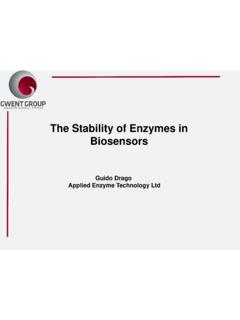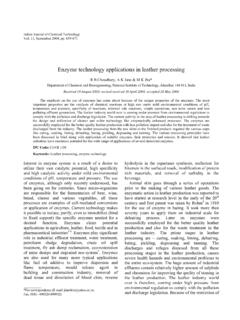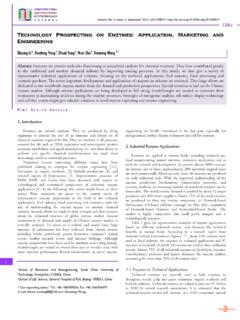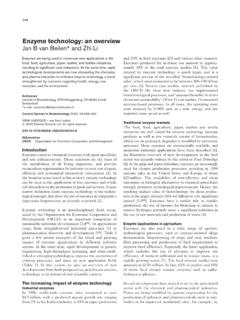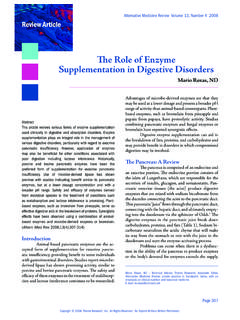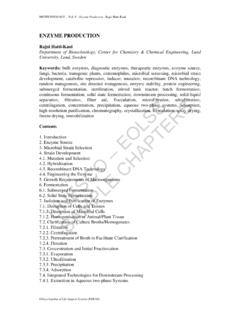Transcription of Sustainable Industrial Development through Enzyme ...
1 IOSR Journal of Biotechnology and Biochemistry (IOSR-JBB) ISSN: 2455-264X, Volume 3, Issue 4 (Jul. Aug. 2017), PP 01-07 DOI: 1 | Page Sustainable Industrial Development through Enzyme technology : An approach toward cleaner production- a literature review *Tahzeeb Bano1, Priyanka2, 1. Research Scholar, Deparment of Biochemistry, Patna University, Patna 2. Research Scholar, Deparment of Biochemistry, Patna University, Patna 3. Head of the Department, Department of Botany, Patna University, Patna Corresponding Author: Tahzeeb Bano Abstract: All stages of the life cycle of a product or process may adversely affect the environment by using up limited resources of materials and energy or by creating waste.
2 Many current products and processes are now regarded as environmentally unfriendly and many are major sources of pollution. Thus, global environmental concerns will drive increased emphasis on clean Industrial products and processes. Any substitution or change that reduces consumption of materials and energy and production of waste may be regarded as more environmentally friendly or clean . Enzyme technology may well be able to provide clean or at least less polluting alternatives to existing practices that generate environment problems over conventional process. enzymes also contribute to safer working conditions through elimination of chemical treatments during production processes.
3 The purpose of this article review is to summarize and discuss the findings of these studies and to recommend further developments regarding environmental assessment and implementation of the technology . The study provide an overview of current and future characteristics of global market for Industrial Enzyme . Keywords: Clean technology , Global Market, Enviromental pollution, Life Cycle Assesment, Bio based product, Government bureauracy ---------------------------------------- ---------------------------------------- ---------------------------------------- --------------- Date of Submission: 12-07-2017 Date of acceptance: 26-07-2017 ---------------------------------------- ---------------------------------------- ---------------------------------------- --------------- I.
4 Introduction In a world with a rapidly increasing population and approaching exhaustion of many natural resources, Enzyme technology offers a great potential for many industries to help meet the challenges they will face in years to come. Industries around the world are looking for alternative technologies that can deliver the increasing numbers of products that are in demand every year while consuming fewer resources and having a lesser impact on the environment. Enzyme technology is a promising means of moving toward cleaner Industrial production over the conventional chemical processes.
5 The introduction of enzymes as effective catalysts working under mild conditions results in significant savings in resources such as energy and water for the benefit of both the industry and the environment. Compared with conventional chemical catalysts, Enzyme catalysis is highly specific and it functions under temperatures, pressures and pHs that are compatible with life. Unlike many processes of conventional synthetic chemistry, enzymes require nontoxic and noncorrosive conditions (Maria Gavrilescua and Yusuf Chisti, 2005). Implementing enzymatic processes in place of conventional processes generally results in a reduced contribution to global warming and also a reduced contribution to acidification, eutrophication, photochemical ozone formation and energy use(Kirk-Othmer, 2005).
6 enzymes are readily biodegradable and usually lead to reduced or no toxicity when they reach the environment after use in Industrial production (Soetaert and Vandamme, 2010). enzymes are mainly proteins produced by all living organisms; they accelerate or catalyse numerous biochemical reactions. enzymes found in nature have been used since ancient times in the production of food products, such as cheese, sourdough, beer, wine and vinegar, and in the manufacture of commodities such as leather, indigo and linen (Ole Kirk, et. al. 2002). The use of enzymes to produce goods for human consumption dates back at least 2000 years, when microorganisms were used in processes such as leavening bread and saccharification of rice in koji production (Demain and Fang, 2000).
7 The mechanism of the enzymes was unknown until 1877, when Moritz Traube proposed that protein-like materials catalyze fermentation and other chemical reactions .. Later, the historic demonstration by Buchner in 1897, showing that alcoholic fermentation could be carried out using cell-free yeast extract, appears to be the first application of biocatalysis. The word zymase was coined to describe this cellfree extract (Bornscheuer and Buchholz, 2005), which was Sustainable Industrial Development through Enzyme technology : An approach toward cleaner DOI: 2 | Page the initial recognition of what is now called an Enzyme .
8 There are currently around 5500 known enzymes (BRENDA, 2012), classified based on the type of reaction they catalyze (oxidoreductases ,transferases , hydrolases , lyases ,Isomerases, ligases). enzymes for Industrial use are produced by growing bacteria and fungi in submerged or solid state fermentation. With submerged being the primary fermentation mode, the unit operations in Enzyme production involve fermentation followed by cell disruption and filtration. The crude Enzyme is further purified by precipitation followed by centrifugation and vacuum drying or lyophilization, collectively known as downstream processing (Kim et al.)
9 , 2009).The Development of fermentation processes during the later part of the last century, aimed specifically at the production of enzymes by use of selected production strains, made it possible to manufacture enzymes as purified, well-characterized preparations even on a large scale. This Development allowed the introduction of enzymes into true Industrial products and processes, for example, within the detergent, textile and starch industries (Ole Kirk, et. al. 2002).Industrially produced enzymes are used in a broad variety of production processes, such as pulp and paper production, leather production, textile production, detergent production, food production, beverage production, animal feed production, pharmaceuticals production, fine chemicals production, cosmetics production and biodiesel production (Kenthorai Raman Jegannathan, Per Henning Nielsen; 2012).
10 The purpose of the present review is therefore: 1) to provide an overview of Life Cycle Assessment (LCA ) and Environmental Impact Assessment ( EIA) studies reported so far comparing enzymatic processes with conventional processes; 2) to summarize the main results of the studies; 3) to draw the general conclusions on whether and to what extent enzymatic or Enzyme -assisted processes are environmentally favourable as alternatives to conventional technology ; 4) to recommend further Development of environmental assessment of enzymatic processes and implementation of Enzyme technology in industry; 5) to provide an overview of current and future characteristics of global market for Industrial Enzyme .











